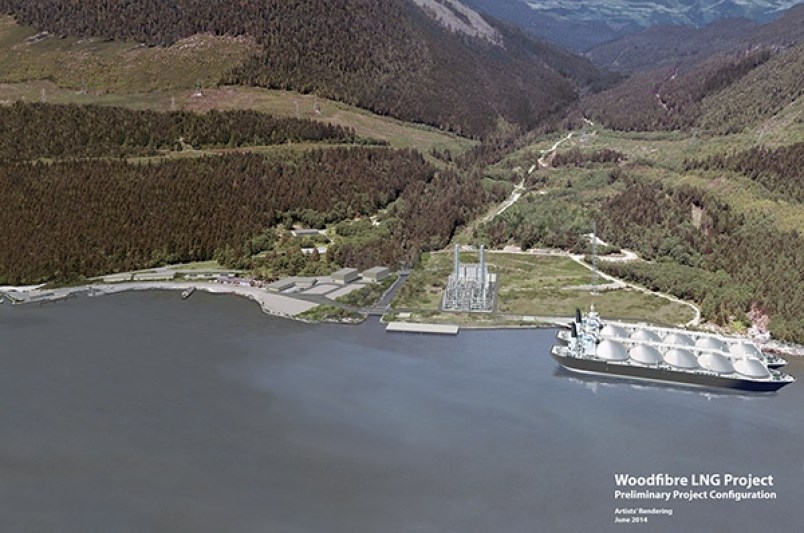Pressure from the Squamish Nation chiefs and council has led Woodfibre LNG to change its planned cooling system for its plant on Howe Sound.
Squamish Nation Chief Ian Campbell confirmed to The Squamish Chief Friday that Woodfibre LNG has switched plans for its liquefied natural gas export facility from a seawater-cooling system to an air-cooling system.
“Squamish Nation council voted on Wednesday to approve air-cooling as the cooling technique for the proposed Woodfibre LNG Project,” Campbell said.
Byng Giraud, vice-president of Woodfibre LNG, said the company’s respect for the Nation is at the heart of the change.
“This was a Squamish Nation decision and a Squamish Nation process,” he said.
“The reason we do this is because we respect our relationship with the Squamish Nation and it was a contractual obligation we made to them.”
The Squamish chiefs and council approved the air-cooling option after earlier rejecting seawater cooling as harmful to fish and marine habitat, Campbell said.
Liquefaction of natural gas creates heat, which can be removed by either seawater cooling or air-cooling.
Local governments and environmentalists have strongly opposed the seawater system since first proposed for several reasons: That it would heat the ocean water around the underwater system, small fish could get caught in the pipes and concern that chlorine used in the process would impact sea life.
“I am glad they are doing it. It is better than the alternative,” said Mayor Patricia Heintzman on Monday. “It has been something the community and First Nations have been pushing for.”
The Squamish Nation set out 25 conditions in October 2015 on which their approval of the liquefied natural gas export facility was based. Dealing with concerns over seawater cooling was one such condition.
“Through our independent Squamish Nation process, we directed Woodfibre LNG to take a second look. As we have repeatedly said, the project will simply not get built unless valuable land and marine environments are protected,” continued Campbell.
Giraud said the air-cooling system, which simply stated works like a car radiator, would be a fundamentally closed loop system.
In previous presentations Woodfibre LNG has said air-cooling was expensive and less energy efficient. The air-cooling system will cost the company more, Giraud said.
“There’s a production loss that results from this decision,” he said. “But we accept that… It is something we think we can overcome.”
The cooling decision is a condition that Woodfibre is legally bound to comply with, according to Campbell.
“The Nation has strong legal remedies such as going to court and revoking the Environmental Certificate,” he said. “This is an important step in the process. But by no means should it be interpreted as a done deal.”
Squamish environmental groups welcomed the change to air-cooling.
“This change is most welcome, as it addresses the very serious concerns expressed by the Squamish Nation, the District of Squamish, Concerned Citizens Bowen, Future of Howe Sound and My Sea To Sky about the damage a once-through seawater cooling would do to the marine life in Howe Sound,” read a joint news release from Concerned Citizens Bowen, and My Sea to Sky
“Both the seawater intakes and hot, chlorinated outfall would have been in the middle of an important herring spawn area in northern Howe Sound.”
Environmentalists still have concerns with the project, however.
“I think this is a fantastic success story for the herring, but there are many other [issues] associated with the proposed Woodfibre LNG project that still need to be addressed,” said Tracey Saxby, co-founder of My Sea to Sky in an email to The Chief.
“Such as safety concerns, air pollution, and the lack of regulation. Canada currently has no safety regulations for LNG tankers, and the information being used by TERMPOL to develop LNG tanker regulations is old or flawed.
“Public safety is not being taken seriously. Based on International Safety Standards we know that Howe Sound is the wrong place for an LNG export facility.”



